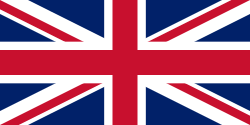 | |
| Use | National flag |
|---|---|
| Proportion | 2:3 |
| Adopted | 6 October 1968 |
| Design | A horizontal triband of blue (top and bottom) and yellow-edged red (triple width) with a large black and white Nguni shield covering two spears and a staff decorated with feather tassels called injobo (bunches of feathers of the widowbird and the lourie) all centered horizontally on the red band |
| Designed by | King Sobhuza II |
 | |
| Use | National flag |
| Proportion | 2:3 |
 | |
| Use | National flag |
| Proportion | 2:3 |
| Adopted | 2011 |

The flag of Eswatini was adopted on 6 October 1968 [1] after Eswatini (then known as Swaziland) gained its independence from the United Kingdom one month before. The design by King Sobhuza II features a black and white shield, with a staff and two spears, on a field of blue, yellow, and red horizontal bands.




